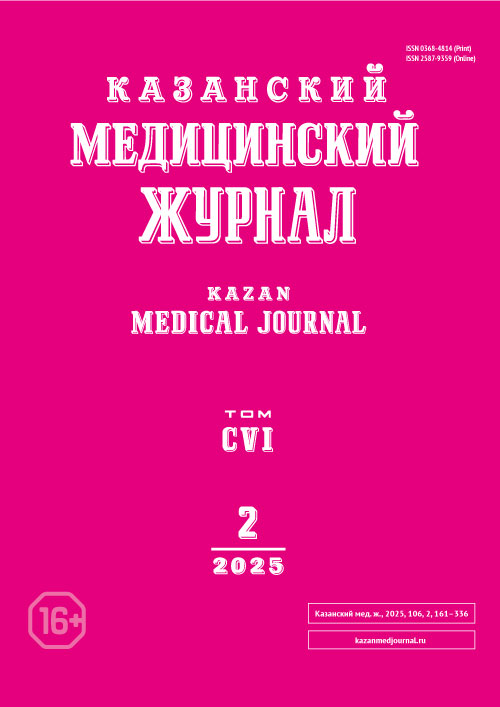Prognostic role of inflammatory response markers in gastric adenocarcinoma
- Authors: Gataullin I.G.1, Gataullin B.I.1,2, Dinov R.M.1, Erpert Y.A.1
-
Affiliations:
- Kazan State Medical Academy — Branch of the Russian Medical Academy of Continuous Professional Education
- Kazan (Volga Region) Federal University
- Issue: Vol 106, No 2 (2025)
- Pages: 172-178
- Section: Theoretical and clinical medicine
- Submitted: 30.10.2024
- Accepted: 20.11.2024
- Published: 14.03.2025
- URL: https://kazanmedjournal.ru/kazanmedj/article/view/640794
- DOI: https://doi.org/10.17816/KMJ640794
- ID: 640794
Cite item
Abstract
BACKGROUND: Prognostic assessment of survival in patients with cancer is essential for guiding treatment strategies, particularly in gastric cancer, which is associated with high morbidity and mortality.
AIM: The study aimed to evaluate the association between inflammatory response markers and survival outcomes in patients with gastric adenocarcinoma.
MATERIAL AND METHODS: The study included 152 patients with histologically confirmed gastric adenocarcinoma. Patients were distributed by stage as follows: 25 (16.45%) with stage I, 25 (16.45%) with stage II, 34 (22.4%) with stage III, and 68 (44.7%) with stage IV disease. Inflammatory response parameters were collected, calculated, and evaluated. The resulting data were analyzed and compared to identify statistically significant associations with overall survival. The inflammatory response parameters included the neutrophil-to-lymphocyte ratio (NLR), platelet-to-lymphocyte ratio (PLR), and monocyte-to-lymphocyte ratio (MLR), as well as two specific indices, systemic immune-inflammation index (SII) and systemic inflammation response index (SIRI), which reflect the activity of inflammatory response in cancer patients and may serve as additional independent prognostic factors. The Mann–Whitney U test was used for two-group comparisons and the Kruskal–Wallis test for comparisons across more than two groups. Spearman’s rank correlation coefficient was used to assess the relationship between inflammatory markers and overall survival. Statistical analysis was performed using MedCalc version 20.104.
RESULTS: No significant associations were observed between inflammatory markers and patients’ age or sex. All inflammatory markers were significantly associated with overall survival (p < 0.001 for NLR, PLR, SII, and SIRI; p = 0.013 for MLR). Elevated levels of these markers correlated with shorter overall survival and a higher probability of stage IV disease.
CONCLUSION: Changes in hematologic markers reflecting systemic immune inflammation and inflammatory response are significantly correlate with survival outcomes in patients with gastric cancer.
Full Text
About the authors
Ilgiz G. Gataullin
Kazan State Medical Academy — Branch of the Russian Medical Academy of Continuous Professional Education
Email: ilgizg@list.ru
ORCID iD: 0000-0001-5115-6388
SPIN-code: 3049-2957
MD, Dr. Sci. (Med.), Prof., Depart. Of Oncology, Radiology and Palliative Medicine
Russian Federation, 36 Butlerova st, Kazan 420012Bulat I. Gataullin
Kazan State Medical Academy — Branch of the Russian Medical Academy of Continuous Professional Education; Kazan (Volga Region) Federal University
Email: bulatg@list.ru
ORCID iD: 0000-0003-1695-168X
SPIN-code: 2977-2970
MD, Cand. Sci. (Med.), Assoc. Prof., Assistant Prof., Depart. Of Surgery, assistant of Depart., Depart. of Oncology, Radiology and Palliative Medicine
Russian Federation, 36 Butlerova st, Kazan 420012; KazanRishat M. Dinov
Kazan State Medical Academy — Branch of the Russian Medical Academy of Continuous Professional Education
Author for correspondence.
Email: rishatdinov@mail.ru
ORCID iD: 0009-0000-8570-5904
SPIN-code: 3954-5643
Resident, Depart. of Oncology, Radiology and Palliative Medicine
Russian Federation, 36 Butlerova st, Kazan 420012Yana A. Erpert
Kazan State Medical Academy — Branch of the Russian Medical Academy of Continuous Professional Education
Email: yana.erpert@bk.ru
ORCID iD: 0009-0007-0937-928X
SPIN-code: 5599-3392
Resident, Depart. of Oncology, Radiology and Palliative Medicine
Russian Federation, 36 Butlerova st, Kazan 420012References
- Cupp MA, Cariolou M, Tzoulaki I, et al. Neutrophil to lymphocyte ratio and cancer prognosis: an umbrella review of systematic reviews and meta-analyses of observational studies. BMC Med. 2020;18(1):360. doi: 10.1186/s12916-020-01817-1
- Brierley JD, Gospodarowicz MK, Wittekind C. TNM classification of malignant tumours. 8th edn. Oxford, UK: Wiley Blackwell, 2017. 272 p.
- Bray F, Laversanne M, Sung H, et al. Global cancer statistics 2022: GLOBOCAN estimates of incidence and mortality worldwide for 36 cancers in 185 countries. CA Cancer J Clin. 2024;74(3):229–263. doi: 10.3322/caac.21834
- Kaprin AD, Starinsky VV, Shakhzadova AO. The state of oncological care for the population of Russia in 2022. Moscow: P.A. Herzen Moscow State Medical Research Institute − branch of the NMIC of Radiology, 2022. 239 p. (In Russ.)
- Matsuoka T, Yashiro M. Biomarkers of gastric cancer: Current topics and future perspective. World J Gastroenterol. 2018;24(26):2818–2832. doi: 10.3748/wjg.v24.i26.2818
- Song XH, Zhang WH, Kai-Liu, et al. Prognostic impact of Borrmann classification on advanced gastric cancer: a retrospective cohort from a single institution in western China. World J Surg Onc. 2020;18(1):204. doi: 10.1186/s12957-020-01987-5
- Qiu MZ, Cai MY, Zhang DS, et al. Clinicopathological characteristics and prognostic analysis of Lauren classification in gastric adenocarcinoma in China. J Transl Med. 2013;11:58. doi: 10.1186/1479-5876-11-58
- Coussens LM, Werb Z. Inflammation and cancer. Nature. 2002;420(6917):860–867. doi: 10.1038/nature01322
- Hanahan D, Weinberg RA. Hallmarks of cancer: the next generation. Cell. 2011;144(5):646–74. doi: 10.1016/j.cell.2011.02.013
- Grivennikov SI, Greten FR, Karin M. Immunity, inflammation, and cancer. Cell. 2010;140(6):883–899. doi: 10.1016/j.cell.2010.01.025
- Zidlik V, Bezdekova M, Brychtova S. Tumor infiltrating lymphocytes in malignant melanoma – allies or foes? Biomed Pap Med Fac Univ Palacky Olomouc Czech Repub. 2020;164(1):43–48. doi: 10.5507/bp.2019.048
- Lin B, Du L, Li H, et al. Tumor-infiltrating lymphocytes: Warriors fight against tumors powerfully. Biomed Pharmacother. 2020;132:110873. doi: 10.1016/j.biopha.2020.110873
- Sarnaik AA, Hwu P, Mulé JJ, Pilon-Thomas S. Tumor-infiltrating lymphocytes: A new hope. Cancer Cell. 2024;42(8):1315–1318. doi: 10.1016/j.ccell.2024.06.015
- Rugambwa TK, Abdihamid O, Zhang X, et al. Neutrophil-lymphocyte ratio and platelet-lymphocyte ratio as potential predictive markers of treatment response in cancer patients treated with immune checkpoint inhibitors: a systematic review and meta-analysis. Front Oncol. 2023;13:1181248. doi: 10.3389/fonc.2023.1181248
- Tan S, Day D, Nicholls SJ, Segelov E. Immune checkpoint inhibitor therapy in oncology: current uses and future directions: JACC: cardioOncology state-of-the-art review. JACC Cardio Oncol. 2022;4(5):579–97. doi: 10.1016/j.jaccao.2022.09.004
- Musaelyan AA, Lapin SV, Urtenova MA, et al. Inflammatory and autoimmune predictive markers of response to anti-PD-1/PD-L1 therapy in NSCLC and melanoma. Exp Ther Med. 2022;24(3):557. doi: 10.3892/etm.2022.11495
- Templeton AJ, McNamara MG, Šeruga B, et al. Prognostic role of neutrophil-to-lymphocyte ratio in solid tumors: a systematic review and meta-analysis. J Natl Cancer Inst. 2014;106(6):dju124. doi: 10.1093/jnci/dju124
Supplementary files











